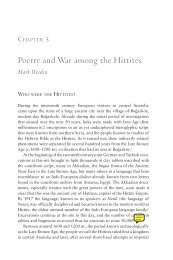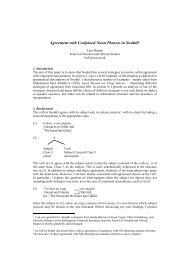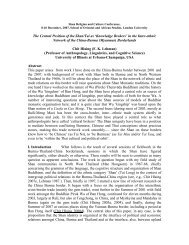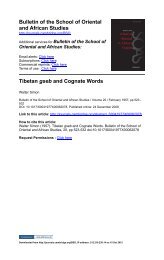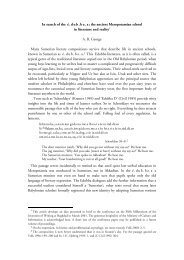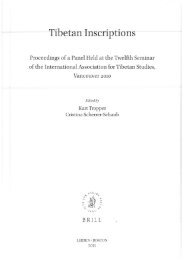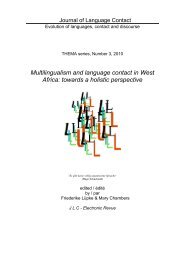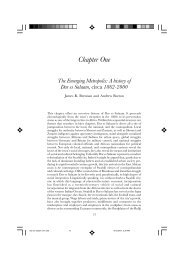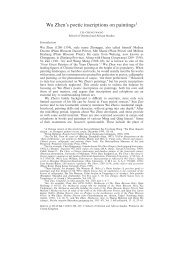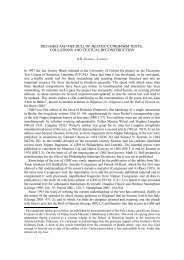Download (316Kb) - SOAS Research Online - The School of ...
Download (316Kb) - SOAS Research Online - The School of ...
Download (316Kb) - SOAS Research Online - The School of ...
You also want an ePaper? Increase the reach of your titles
YUMPU automatically turns print PDFs into web optimized ePapers that Google loves.
248 almut hintze<br />
aˇsmnō.janō bauuaiti<br />
yaϑa gran. tō upa.t<br />
˜ biˇstō<br />
apaiti.zan. tō miϑnāiti<br />
miϑrō yō vouru.gaoiiaoitiˇs<br />
vazracit<br />
˜ aēˇs am huniuuixta<br />
yōi niγrāire sarahu maˇs. iiākan am<br />
aˇsmnō.janō bauuaiti<br />
yaϑa gran. tō upa.t<br />
˜ biˇstō<br />
apaiti.zan. tō miϑnāiti<br />
miϑrō yō vouru.gaoiiaoitiˇs<br />
<strong>The</strong>ir very swords, well wielded,<br />
whicharebroughtdownontheheads<strong>of</strong>men,<br />
do not slay with the blade 4<br />
because Mithra <strong>of</strong> wide cattle-pastures,<br />
who has not been acknowledged, remains 5 enraged, provoked.<br />
<strong>The</strong>ir very cudgels, well directed,<br />
whicharebroughtdownontheheads<strong>of</strong>men,<br />
do not slay with the blade<br />
because Mithra <strong>of</strong> wide cattle-pastures,<br />
who has not been acknowledged,<br />
remains enraged, provoked.<br />
<strong>The</strong> Avestan form niγrāire would thus attest a root present <strong>of</strong> gar ‘to raise<br />
(one’s hand or weapon preparatory to striking)’ which, according to Bailey, forms<br />
a reduplicated present jígharti in Vedic. More importantly, he equates the Av.<br />
phrase vazra o ... niγrāire (Yt 10.40) with the Ved. expression vájram ´ā jigharti<br />
(RV 5.48.3) which he translates as ‘he brings the club down upon’. While Grassmann<br />
421 regards jigharti in RV 5.48.3 and 4.17.14 as a present <strong>of</strong> the root ghar<br />
‘to drip, sprinkle’, which here would have the meaning ‘to throw’, Bailey 1956,<br />
98 f. points out the semantic difficulty presented by such divergent meanings and,<br />
taking up Geldner’s earlier suggestion, posits a separate Vedic root ghar, which<br />
would be a variant <strong>of</strong> har ‘to take’. 6<br />
4 If it is accepted that in the course <strong>of</strong> transmission <strong>of</strong> the text metathesis <strong>of</strong> -nm- to<br />
-mn- occurred, possibly under the influence <strong>of</strong> the middle participles’ suffix, then the<br />
first member <strong>of</strong> the compounds aˇsmnō.jan- ‘not slaying with the blade’ and aˇsmnō.vid-<br />
‘not piercing with the blade’ is ˇsanman- ‘blade’. Av.ˇsanman- has been equated by both<br />
Humbach and Henning with Ved. ks.ádman- ‘blade’, see Kellens, Noms-racines 71 f.,<br />
Mayrh<strong>of</strong>er, EWAia I 422 with references.<br />
5 <strong>The</strong> form miϑnāiti belongs to the verb mit ‘to remain, rest’, see Kellens, Verbe av. 177<br />
with n. 11.<br />
6 Geldner, Rig-Veda III 128 ad 10.6.4 d; II 54 ad 5.48.3 b. Bailey 1956, 98 also notes that<br />
Geldner does not refer to Iranian. That Av. gar ‘prendre’ corresponds to Ved. har is also<br />
suggested by Benveniste, Journal Asiatique 225, 1934, 178-180, but the Av. compounds<br />
with aib˘ī, adduced by him, belong to gar ‘to welcome’, see Kellens, Noms-racines 21-27,



